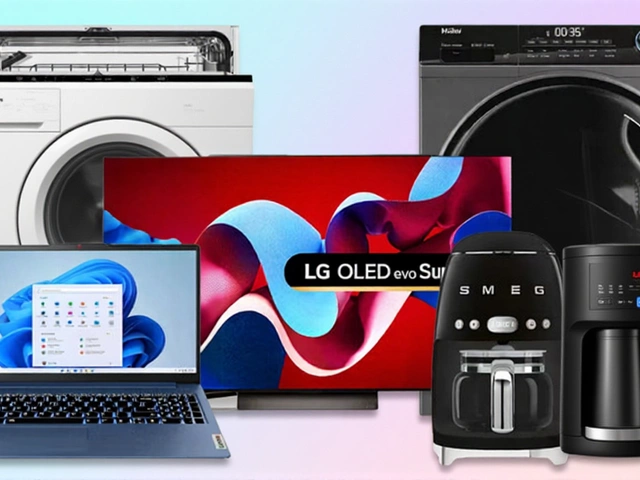When Huawei unveiled the Watch GT 6 Series on September 19, 2025, it didn’t just drop a new smartwatch—it rewrote the rules of what a wearable can do. The standout? A High-Silicon Stacked Battery that delivers up to 21 days of battery life in power-saving mode. That’s not a marketing exaggeration. It’s a 65% jump in capacity over the previous GT5 Pro, confirmed by leaked internal specs and verified by independent reviewers. For context: most premium smartwatches—Samsung, Apple, Fitbit—struggle to hit three days. Huawei just turned a daily charging ritual into a monthly event.
How the Battery Breakthrough Actually Works
The secret sauce isn’t just bigger. It’s smarter. Huawei’s new High-Silicon Stacked Battery uses a proprietary silicon-carbon anode structure that increases energy density by 37% without swelling the size. The 46mm models, including the Watch GT 6 Pro, pack an 867mAh cell—nearly double the 41mm model’s 540mAh. That’s the kind of engineering that makes engineers nod silently in the lab.
According to Huawei’s official testing protocol—published on its UK site—battery life was measured under brutal conditions: 30 minutes of weekly Bluetooth calls, daily heart rate monitoring, sleep tracking, 180 minutes of weekly workouts, 50 messages, six calls, and three alarms per day, plus 30 minutes of screen-on time. Even then, the Pro model delivered 12 days under typical use, and seven days with Always-On Display enabled. Wireless charging? 95 minutes for the larger models. That’s faster than most phones.
More Than Just Battery Life
But Huawei didn’t stop at endurance. The Watch GT 6 Pro introduces what the company calls the world’s first smartwatch-integrated cycling power meter. No external sensors. No clip-on gadgets. The watch itself measures Functional Threshold Power (FTP)—a key metric for serious cyclists—using its built-in 9-axis accelerometer and advanced motion algorithms. It’s a game-changer for amateur triathletes and weekend warriors who’ve spent hundreds on Garmin or Wahoo accessories.
Health tracking? It’s comprehensive. ECG, SpO2, stress monitoring, menstrual cycle tracking, and what Huawei calls “true sleep” technology—analyzing sleep stages with deeper precision than previous models. The device also boasts dual-band GPS, Bluetooth 6.0, NFC for contactless payments, and 50-meter water resistance. You can swim with it. Run in the rain. Even shower without removing it.
What Reviewers Are Saying
Independent voices are backing Huawei’s claims. Tech Spurt’s YouTube review (video ID: OnAVzEfHQnk), published the same day as the launch, called the GT 6 Pro “one of my top favourite 46mm smartwatches in 2025 with the best battery life around.” He noted the switch from old battery tech to silicon-carbon was “a massive leap.” Unbox PH’s review (S7ctb2nCtlY), posted a week later, was even more direct: “21 Days of Battery Life is no joke when it comes to Smartwatches!”
There’s a catch, though. The watch runs on HarmonyOS, not Wear OS or watchOS. Tech Spurt admitted it “misses some features” like seamless Google integration, but praised the smooth haptics, reliable Bluetooth streaming, and minimal lag. For users already in Huawei’s ecosystem—phones, tablets, earbuds—it’s seamless. For Android or iPhone users relying on Google Fit or Apple Health? There’s friction.
Pricing and Market Positioning
The Watch GT 6 starts at €249 (£215), while the Watch GT 6 Pro begins at €379 (£329). That puts it squarely against the Apple Watch Ultra 2 and Samsung Galaxy Watch 7 Pro—but with a battery advantage no competitor can match. The Pro model’s cycling power meter alone justifies the premium for fitness enthusiasts. And with U.S. trade restrictions still limiting access to Google Mobile Services, Huawei is doubling down on its strength: long battery life, health depth, and ecosystem loyalty.
This isn’t just a product update. It’s a statement. In a market where smartwatches are becoming disposable gadgets, Huawei is betting on durability—both in hardware and user experience. The GT 6 Series isn’t trying to be an iPhone replacement. It’s trying to be your last watch.
What’s Next for Huawei Wearables?
With the GT 6 Series, Huawei has cemented its position as the leader in endurance-focused wearables. But the next frontier? AI-driven health insights. The company has hinted at machine learning models for early detection of arrhythmias and sleep apnea—features already being tested in clinical trials. If they roll out in the GT 7, expect the industry to scramble. For now, the GT 6 Pro stands alone: a watch that doesn’t just keep time, but keeps going—long after everyone else has run out of juice.
Frequently Asked Questions
How does the Huawei Watch GT 6 Pro’s battery life compare to the Apple Watch Ultra 2?
The Apple Watch Ultra 2 lasts about 36 hours with heavy use and up to 72 hours in low-power mode. The Huawei Watch GT 6 Pro lasts 7 days with Always-On Display enabled and up to 21 days in power-saving mode—nearly three times longer than Apple’s best. Even under typical use, Huawei delivers 12 days versus Apple’s 1.5 days.
Can the cycling power meter work without a smartphone?
Yes. The GT 6 Pro’s cycling power meter operates entirely on-device using its internal sensors and algorithms. It doesn’t require a paired phone or external sensor to calculate FTP. Data syncs to your phone later via Bluetooth, but real-time metrics like power output and cadence are displayed live on the watch face.
Is the Huawei Watch GT 6 compatible with iPhones?
Yes, but with limitations. The watch pairs with iOS via Huawei’s Health app, which supports heart rate, sleep, and activity tracking. However, it lacks deep integration with Apple Health, and notifications may be delayed. Google services like Maps or Gmail aren’t available, so Android users get a smoother experience.
Why doesn’t Huawei use Wear OS like Samsung?
U.S. trade restrictions since 2019 blocked Huawei from licensing Google Mobile Services, including the Play Store and core Android APIs. Huawei developed HarmonyOS as a full alternative. While it lacks some third-party apps, it’s optimized for battery efficiency and hardware integration—key reasons why the GT 6 Pro outlasts Wear OS rivals.
What’s the difference between the GT 6 and GT 6 Pro?
The Pro model has a larger 867mAh battery (vs. 540mAh), titanium casing, integrated cycling power meter, enhanced GPS accuracy, and a slightly higher-resolution display. The standard GT 6 lacks the power meter and has a polycarbonate body. Both share the same health sensors and HarmonyOS, but the Pro is built for serious athletes.
Will Huawei release a GT 7 with AI health features soon?
While unconfirmed, Huawei has filed patents for AI-driven arrhythmia and sleep apnea detection using wearable sensor data. Leaked internal roadmaps suggest a GT 7 launch in late 2026, possibly with FDA-cleared health diagnostics. If true, it could position Huawei as the first non-medical device company to offer clinical-grade insights on a consumer smartwatch.








Write a comment